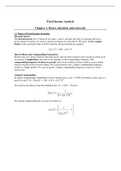Fixed Income Analysis
Chapter 1: Basics, duration and convexity
1.1 Basics of Fixed Income Securities
Discount factors
The discount factor Z(t, T) between two dates, t and T, provides the term of exchange between a
given amount of money at t versus a amount of money at a later date T. The price of zero coupon
bonds (with a principal value of $100) issued by the government are equal to:
𝑃𝑧 (𝑡, 𝑇) = 100 × 𝑍(𝑡, 𝑇)
Interest Rates and Compounding Frequencies
Interest rates are closely related to discount factors and are more similar to the concept of return on an
investment. Complication: the interest rate depends on the compounding frequency. The
compounding frequency of interest accruals refers to the number of times within a year in which
interest are paid on the invested capital. For a given interest rate, a higher compounding frequency
results in a higher payoff. For a given payoff, a higher compounding frequency results in a lower
interest rate.
Annual Compounding
In annual compounding, bondholders receive interest once a year. A $100 investment at time t gives a
payoff at time T of: 𝑃𝑎𝑦𝑜𝑓𝑓 = 100 × [1 + 𝑟1 (𝑡, 𝑇)]T-t
The interest rate follows from the definition 𝑍(𝑡, 𝑇) = 100 ÷ 𝑃𝑎𝑦𝑜𝑓𝑓
The annual compounding rate can also be written as:
,More Frequent Compounding
In more frequent compounding, bondholders receive interest more than once a year. A $100
investment at time t gives a payoff at time T of: 𝑃𝑎𝑦𝑜𝑓𝑓 = 100 × (1 + 𝑟𝑛 (𝑡, 𝑇) ÷ 𝑛)n x (T – t)
The interest rate follows from the definition 𝑍(𝑡, 𝑇) = 100 ÷ 𝑃𝑎𝑦𝑜𝑓𝑓
The more frequent compounding rate can also be written as:
Continuous Compounding
The continuously compounding interest rate is obtained by increasing the compounding frequency n
to infinity. The continuously compounded interest rate r(t, T) is given by:
𝑍(𝑡, 𝑇) = 𝑒 −𝑟(𝑡,𝑇) (𝑇−𝑡)
Solving for r(t, T) we obtain
ln (𝑍(𝑡, 𝑇))
r(t, T) = −
𝑇−𝑡
The higher the compounding frequency, the lower the interest rate.
The term Structure of Interest Rates
The term structure of interest rates, or spot curve, or yield curve, at a certain time t defines the
relation between the level of interest rates and their time to maturity T – t. The term structure varies
over time, and may take different shapes.
No Arbitrage and the Law of One Price
An Arbitrage Opportunity is a feasible trading strategy involving two or more securities with either:
- No cost a initiation, and generating a sure positive profit by a certain date in the future.
- Generates a positive payoff at initiation, and it has a sure non-negative payoff by a certain date
in the future.
The No Arbitrage condition requires that no arbitrage opportunity exist. Implies Law of One Price:
assets with same payoff have same price.
,Interpolating discount factors
In practice the bootstrap method might break down, in particular because reliable prices of liquid
bonds might not be available for all maturities; this is often the case for long maturities. Furthermore,
because new bonds are not issued every day, we might have discount factors for 𝑇 = 0.4, 0.9, 1.4 etc.
and 𝑇 = 0.1, 0.6, 1.1 etc. but not 𝑇 = 0.5, 1, 1.5. Both problems motivate the use of interpolation of
the term structure, such as:
- Splines
- Nelson-Siegel method
These methods try to fit the term structure with a small number or parameters.
Nelson-Siegel method
In the Nelson-Siegel method, the zero-coupon interest rates 𝑟(𝑡, 𝑇) and discount factors 𝑍(𝑡, 𝑇) are
given by:
And,
The parameter ∅0 controls the level of the term structure. The slope is determined by ∅1 . The
parameters ∅2 and 𝜆 determine the curvature/ shape of the term structure.
, Floating Rate Bonds
A semi-annual Floating Rate Bond with maturity T is a bond whose coupon payments 𝑐(𝑇𝑖 ) at dates
𝑇1 = 0.5, 𝑇2 = 1, 𝑇3 = 1.5, … , 𝑇𝑛 = 𝑇 are determined by the formula:
(𝑟2 (𝑇𝑖 − 0.5) + 𝑠)
𝑐(𝑇𝑖 ) = 100 ×
2
where 𝑟2 (𝑡) = 𝑟2 (𝑡, 𝑡 + 0.5) is the 6-month Treasury rate at t, and s is a spread. Each coupon date is
also called reset date as it is the time when the new coupon is reset. Effectively the spread is a fixed
payment on the bond so we can value it separately:
𝑛
𝑠
Price with spread = 𝑃𝑟𝑖𝑐𝑒 𝑜𝑓 𝑛𝑜 𝑠𝑝𝑟𝑒𝑎𝑑 𝑏𝑜𝑛𝑑 + 100 × ∑ Z(0, t)
2
𝑡=0.5
How do we value a floating rate bond outside the reset dates? Let the current date t between the reset
dates 𝑇𝑖 and 𝑇𝑖+1 .
We know that the bond will pay off 100 + 𝑐(𝑇𝑖+1 ) at the next reset date 𝑇𝑖+1 and note that
𝑐(𝑇𝑖+1 ) = 100 × 𝑟2 (𝑇𝑖 ) ÷ 2 is known at 𝑡 > 𝑇𝑖 . All we need do is to apply the appropriate discount to
the payoff. The general price formal for a semi-annual floating rate bond is.
𝑃𝐹𝑅 (𝑡, 𝑇) = 𝑍(𝑡, 𝑇𝑖+1 ) × 100 × [1 + 𝑟2 (𝑇𝑖 ) ÷ 2]
Where 𝑍(𝑡, 𝑇𝑖+1 ) is the discount factor from t to 𝑇𝑖+1.
Forward Rates
The forward rate is defined as
And
Where 𝐹(𝑡, 𝑇1 , 𝑇2 ) is the forward discount factor






